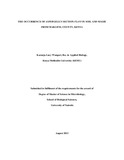| dc.description.abstract | Maize (Zea mays L.) is the staple food for most households in both urban and rural areas in Kenya and has an estimated annual per capita consumption of about 125 kg per person, which is among the highest in the world. Ear rot fungi belonging to the genera Fusarium, Aspergillus and Penicillium are the commonly encountered mycotoxigenic agents on maize in tropical regions of Kenya. Amongst the three, Aspergillus genus is the most important aflatoxigenic fungal species that infect maize along the value chain. Contamination of maize by these toxigenic fungi has become a challenging problem especially in many Counties in Kenya where repeated cases of acute aflatoxicosis have been reported yearly for over three decades now (2013).
The study focused on the maize value chain to determine the occurrence of Aspergillus flavus (S and L strain), Aspergillus parasiticus and Aspergillus alliaceus in soil and maize. The samples were collected from Kaiti Location in Makueni County for three seasons from 2009-2011. A stratified sampling approach was used to collect 521 samples consisting of 80 soil samples, 96, 190 and 155 maize samples for pre-harvest, farmer stores and market stores respectively. Isolation of ASF was done on Modified Dichloran Rose Bengal (MDRB) agar at 30 0 C. Thin Layer Chromatography (TLC) was used to screen isolates of A. flavus and A. parasiticus for aflatoxin production and type using aflatoxin standards (AFB1, AFB2, AFG1 and AFG2).
Total colony forming units (CFU) and prevalence data was taken. Aspergillus and Penicillium species were recovered in every stage of the maize value chain. Ninety percent of the sampled farms had Aspergillus section Flavi (ASF) fungi, A. flavus (S and L strains), and A. parasiticus. The mean population (CFU g-1of maize) of ASF was significantly different (P<0.05) in the three seasons (mean = 1090 in 2009, 5552 in 2010 and 25664, in 2011) and their population in maize was higher in 2011 than in soil. A. flavus S strain had the highest population in maize (mean = 24256 CFU g-1 of maize), followed by A. flavus L strain (mean =13421 CFU g-1 of maize) and A. parasiticus (mean=1643 CFU g-1 of maize). An association was noted between soil type and distribution pattern of fungal species in maize growing farms in Kaiti. Loam (mean= 213 CFU g-1 of soil) and red loam (mean = 222 CFU g-1 of soil) soils had the highest fungal population while black loam (mean= 31 CFU g-1 of soil) and sandy (mean= 17 CFU g-1 of soil) soils had the least. There was a significant difference (P<0.05) in the population of ASF in local (mean = 6347 CFU g-1 of maize) and hybrid (mean = 30933 CFU g-1 of maize) maize varieties. Local maize was more tolerant to fungal infection than hybrid maize varieties at pre-harvest stage. Fungal populations in the two maize types were not statistically different at post harvest stage.
The population of A. flavus S strain was higher in all sample types but significantly higher (P<0.001) in market than in farmer stored samples. Maize hanged on roof and drying on mats had a significantly (P<0.001) lower ASF incidence, with means of 65 and 1200 CFU g-1 of maize respectively. Samples in storage for 15-25 days had a significantly lower (P<0.001) mean fungal population of 1100 CFU g-1 of maize which increased with time to 7200 colonies at 105 days in market and 11000 CFU g-1 of maize at 330 days in farmer stored maize. Four aflatoxin types AFB1, AFB2, AFG1 and AFG2) were detected from colonies isolated from maize and soil but the incidence differed in soil (AFB1 = 50 and AFB2 = 47) and maize samples (AFB1 = 63 and AFB2 = 59). Aspergillus flavus S and L strains were found to be present in every stage of the maize value chain but severity of contamination at pre and post-harvest stages depended on the moisture content, source of maize, duration and type of storage (P = 0.042). Data gathered showed a potential risk of contamination of maize in the study area hence farmers need to be sensitized on good agricultural practices to minimize maize contamination. The results are useful as a guide towards the management of aflatoxin occurence in Kenya. | en |

